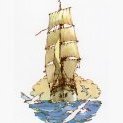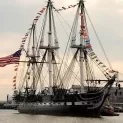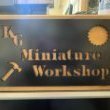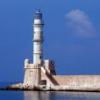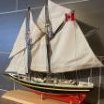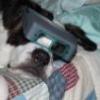MORE HANDBOOKS ARE ON THEIR WAY! We will let you know when they get here.
×
-
Posts
2,588 -
Joined
-
Last visited
Reputation Activity
-
 JSGerson got a reaction from mtbediz in USS Constitution by Der Alte Rentner - Model Shipways - 1/76
JSGerson got a reaction from mtbediz in USS Constitution by Der Alte Rentner - Model Shipways - 1/76
OK, now we know that Mustafa is building the 2015 version (no top gallant rail except for the bow), you are building the 1927 version (top gallant rail all around), and I'm building the present day version (no top gallant rail at all) of the USS Constitution. The other two most common versions are 1797 launch and the War of 1812. This is why I have always said you must decide what era you are modeling right at the beginning of your build and stick to it. Note, the MS kit is based on the 1927 restoration and BlueJacket and Revell are based on 1812. I don't know what the others (that I know about) are officially based on (Mamoli, Mantua, Constructo, Billing Boats, and Scientific).
Jon
-
 JSGerson got a reaction from Der Alte Rentner in USS Constitution by Der Alte Rentner - Model Shipways - 1/76
JSGerson got a reaction from Der Alte Rentner in USS Constitution by Der Alte Rentner - Model Shipways - 1/76
My fears are allayed, it looks great.
Jon
-
 JSGerson got a reaction from mtbediz in USS Constitution by mtbediz - 1:76
JSGerson got a reaction from mtbediz in USS Constitution by mtbediz - 1:76
Now why didn't I think of that. Great solution!
Jon
-
 JSGerson got a reaction from Unegawahya in USS Constitution by mtbediz - 1:76
JSGerson got a reaction from Unegawahya in USS Constitution by mtbediz - 1:76
Now why didn't I think of that. Great solution!
Jon
-
 JSGerson got a reaction from mtbediz in USS Constitution by Unegawahya - Model Shipways - scale 1:76
JSGerson got a reaction from mtbediz in USS Constitution by Unegawahya - Model Shipways - scale 1:76
Beautiful and the rigging securing the boat to the the hatch is nice and clean. Well done!
Jon
-
 JSGerson got a reaction from Unegawahya in USS Constitution by Unegawahya - Model Shipways - scale 1:76
JSGerson got a reaction from Unegawahya in USS Constitution by Unegawahya - Model Shipways - scale 1:76
Beautiful and the rigging securing the boat to the the hatch is nice and clean. Well done!
Jon
-
 JSGerson got a reaction from Der Alte Rentner in USS Constitution by Der Alte Rentner - Model Shipways - 1/76
JSGerson got a reaction from Der Alte Rentner in USS Constitution by Der Alte Rentner - Model Shipways - 1/76
Nice save. My only concern is when you stain the wood, the stain may accentuate the break lines. In hindsight, I might have started over and drilled the holes starting with a very small diameter and working my way to the target size with larger and larger drill bits or round files. Small pieces of Basswood are quite fragile, so maybe a harder wood like boxwood might have helped. I realize this advice is a bit late now, but hopefully, may be useful in the future.
Jon
-
 JSGerson got a reaction from GGibson in USS Constitution by Der Alte Rentner - Model Shipways - 1/76
JSGerson got a reaction from GGibson in USS Constitution by Der Alte Rentner - Model Shipways - 1/76
Peter, while perusing the Ships of Scale site, I ran into a general broadcast for someone who lives in South Carolina, who would be willing to go to Charlestown SC area, specifically Patriots Point Maritime Museum to photograph some Dahlgren Guns which are on display. He wants to build a 1/10 scale model of one of the guns but didn't have any good photographs of them. He lives in Australia, so going there himself would pf been a bit of an effort. I decided that it would be a nice day trip for me, so I did as he asked. He was very happy with my pictures and said to watch his website when he starts the project. I looked at his site and discovered that he completed a model of the USS Constitution in natural wood like you. Although his is a Mamoli model, I thought you might be interested. His name is John Viggars at Johnsmachines.com. Scroll down to May 4, 2024 "Unboxing for Grandfathers."
Jon
-
 JSGerson got a reaction from GGibson in USS Constitution by mtbediz - 1:76
JSGerson got a reaction from GGibson in USS Constitution by mtbediz - 1:76
It loaded just fine for me
-
 JSGerson got a reaction from mtbediz in USS Constitution by mtbediz - 1:76
JSGerson got a reaction from mtbediz in USS Constitution by mtbediz - 1:76
It loaded just fine for me
-
 JSGerson got a reaction from mort stoll in USS Constitution by mtbediz - 1:76
JSGerson got a reaction from mort stoll in USS Constitution by mtbediz - 1:76
Nice, clean, and precise...your usual excellence!
Jon
-
 JSGerson got a reaction from kgstakes in USS Constitution by mtbediz - 1:76
JSGerson got a reaction from kgstakes in USS Constitution by mtbediz - 1:76
It's a nice optical illusion. I used the same method for the bolts on those big wooden cleats on the spar deck.
-
 JSGerson got a reaction from KARAVOKIRIS in USS Constitution by mtbediz - 1:76
JSGerson got a reaction from KARAVOKIRIS in USS Constitution by mtbediz - 1:76
Beautifully done as I would expect. I have only one comment. Some time ago you mentioned that your model is based on what the real ship looks like TODAY. However, and I really hate to mention this as it would mean changing what you just did, today's ship does NOT have the bow topgallant rail ("bow rail") anymore since the ship's last restoration in 2015-17. Of course I could be wrong in your intensions; I do hope I'm wrong.
Jon
-
 JSGerson got a reaction from GGibson in USS Constitution by mtbediz - 1:76
JSGerson got a reaction from GGibson in USS Constitution by mtbediz - 1:76
The ship gets a restoration, large or small, about every 20 years or so. Copper is replaced, wood repaired, and sometimes structure is modified. As I understand it, and I may be wrong, the 1927-31 restoration made some changes that were not correct. The wrong model of carronades is one example and the addition of the topgallant rail, now completely removed, is another. Slowly, the ship will be restored to look more like she did in 1812... I think. Whether they will change the transom, the most obvious transformation in the future, who knows.
Jon
-
 JSGerson got a reaction from mtbediz in USS Constitution by mtbediz - 1:76
JSGerson got a reaction from mtbediz in USS Constitution by mtbediz - 1:76
The ship gets a restoration, large or small, about every 20 years or so. Copper is replaced, wood repaired, and sometimes structure is modified. As I understand it, and I may be wrong, the 1927-31 restoration made some changes that were not correct. The wrong model of carronades is one example and the addition of the topgallant rail, now completely removed, is another. Slowly, the ship will be restored to look more like she did in 1812... I think. Whether they will change the transom, the most obvious transformation in the future, who knows.
Jon
-
 JSGerson got a reaction from Unegawahya in USS Constitution by mtbediz - 1:76
JSGerson got a reaction from Unegawahya in USS Constitution by mtbediz - 1:76
Wow, I really kicked a hornet's nest, resulting in these conversations since I turned off the computer last night. It's now the next morning,
Yes, the 3D tour took place in 2015, before the last restoration where the bow topgallant rail was removed. So now Mustafa, you are officially locked into 2015 as the era of your model.
Yes, the carronades on the the actual ship are incorrect except for the two with the screw elevation control. I plan on installing the screw type for ALL the carronades on my model. Will see how that goes when the time comes.
Remember, you are the captain of your ship and you determine what it should look like.
Jon
-
 JSGerson got a reaction from PaddyO in USS Constitution by mtbediz - 1:76
JSGerson got a reaction from PaddyO in USS Constitution by mtbediz - 1:76
Wow, I really kicked a hornet's nest, resulting in these conversations since I turned off the computer last night. It's now the next morning,
Yes, the 3D tour took place in 2015, before the last restoration where the bow topgallant rail was removed. So now Mustafa, you are officially locked into 2015 as the era of your model.
Yes, the carronades on the the actual ship are incorrect except for the two with the screw elevation control. I plan on installing the screw type for ALL the carronades on my model. Will see how that goes when the time comes.
Remember, you are the captain of your ship and you determine what it should look like.
Jon
-
 JSGerson got a reaction from Der Alte Rentner in USS Constitution by mtbediz - 1:76
JSGerson got a reaction from Der Alte Rentner in USS Constitution by mtbediz - 1:76
Beautifully done as I would expect. I have only one comment. Some time ago you mentioned that your model is based on what the real ship looks like TODAY. However, and I really hate to mention this as it would mean changing what you just did, today's ship does NOT have the bow topgallant rail ("bow rail") anymore since the ship's last restoration in 2015-17. Of course I could be wrong in your intensions; I do hope I'm wrong.
Jon
-
 JSGerson got a reaction from Der Alte Rentner in USS Constitution by Der Alte Rentner - Model Shipways - 1/76
JSGerson got a reaction from Der Alte Rentner in USS Constitution by Der Alte Rentner - Model Shipways - 1/76
Looks good to me!
Jon
-
 JSGerson got a reaction from PaddyO in USS Constitution by mtbediz - 1:76
JSGerson got a reaction from PaddyO in USS Constitution by mtbediz - 1:76
Beautifully done as I would expect. I have only one comment. Some time ago you mentioned that your model is based on what the real ship looks like TODAY. However, and I really hate to mention this as it would mean changing what you just did, today's ship does NOT have the bow topgallant rail ("bow rail") anymore since the ship's last restoration in 2015-17. Of course I could be wrong in your intensions; I do hope I'm wrong.
Jon
-
 JSGerson got a reaction from mtbediz in USS Constitution by mtbediz - 1:76
JSGerson got a reaction from mtbediz in USS Constitution by mtbediz - 1:76
Beautifully done as I would expect. I have only one comment. Some time ago you mentioned that your model is based on what the real ship looks like TODAY. However, and I really hate to mention this as it would mean changing what you just did, today's ship does NOT have the bow topgallant rail ("bow rail") anymore since the ship's last restoration in 2015-17. Of course I could be wrong in your intensions; I do hope I'm wrong.
Jon
-
 JSGerson got a reaction from Stevenleehills in USS Constitution by JSGerson - Model Shipways Kit No. MS2040
JSGerson got a reaction from Stevenleehills in USS Constitution by JSGerson - Model Shipways Kit No. MS2040
Unegawahya - Tenacity, sheer unmeditated tenacity is all it took.
Jon
-
 JSGerson got a reaction from Unegawahya in USS Constitution by JSGerson - Model Shipways Kit No. MS2040
JSGerson got a reaction from Unegawahya in USS Constitution by JSGerson - Model Shipways Kit No. MS2040
Unegawahya - Tenacity, sheer unmeditated tenacity is all it took.
Jon
-
 JSGerson got a reaction from Der Alte Rentner in USS Constitution by JSGerson - Model Shipways Kit No. MS2040
JSGerson got a reaction from Der Alte Rentner in USS Constitution by JSGerson - Model Shipways Kit No. MS2040
Unegawahya - Tenacity, sheer unmeditated tenacity is all it took.
Jon
-
 JSGerson got a reaction from Geoff Matson in USS Constitution by The Bitter End - Model Shipways - 1:76
JSGerson got a reaction from Geoff Matson in USS Constitution by The Bitter End - Model Shipways - 1:76
Marcus K - The original posting of Antczak's model images were originally on American Marine Models' website, but have since been removed. They have a memorial to Mark Antczak's memory which states in part:
However, I have not been able to locate an original source for those images now. But all is not lost, I made a copy of them as well as Usetosail who posted them on his build log of the USS Constitution post No. 556. Here are all that I have have plus three additional photos that Usetosail did not post.




